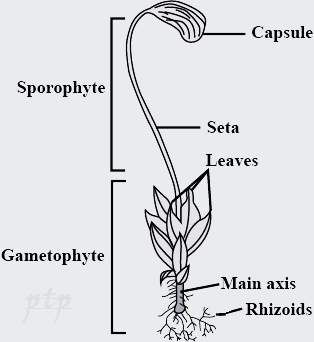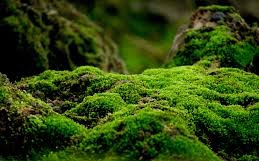Biology (Elective), Life Process of Moss and Fern.

Life Process of Moss and Fern.
MOSS

Mosses are small, simple green, seedless, nonvascular plants called Bryophytes.
They are simple plants because their roots, stem, and leaves lack vascular bundle (xylem and phloem) and little or no strengthening tissue.
Moss grows in clusters to enable them to conserve water.
They are regarded as lower plants.
Biological classification:
Phylum/Division Bryophyta
Reasons:
- Their leaves and stems lack vascular tissue.
- They are seedless and produce no flowers.
- Presence of thalloid body.
- Presence of dominant gametophyte.
- Presence of capsule raised on a stalk
Class Musci
Reasons:
- The gametophytes grow from a protonema that may be prostate or upright.
- The stem is surrounded by thin spirally arranged leaf-like structures.
- They lack true roots, stems, and leaves.
- The sporophyte is small in size.
Typical examples are
- Brachymenium,
- Funaria,
- and Sphagnum.
Habitat:
- Moist or dump soil.
- As epiphytes or parasites on the branches of some forest trees
Reasons why moss is confined to a moist habitat.
- Moist habitat due to the absence of a cuticle.
- Moisture is also needed for fertilization. Thus, the sperm cells from the antheridium swim to the archegonium to fertilize the egg.
Adaptive features of moss to its habitat
- Presence of rhizoids for anchorage.
- Presence of capsule raised on a stalk for easy dispersal of spores.
- Soft and flexible body.
- Seta which supports the capsule.
Reproduction in Moss is an alternation of generations
Sexual reproductive structure.
- Archegonium (female reproductive part)
- Antheridium (male reproductive part.
Asexual reproductive structure.
- Capsule which contains asexual spores.
Reproduction processes in moss
The life cycle or growth process in Moss is an alternation of generations.
This means it involves two alternating generations which are;
- the diploid sporophyte and
- the haploid gametophyte.
The gametophyte which is a haploid is dominant to the sporophyte.
The male organ is called antheridium and the female the archegonium.
The antheridium and the archegonium are borne at the tip of the gametophytes or both the male and the female on the same plant.
Antheridium produces sperm with two flagella called antherozoids.
The archegonium produces an egg called the oosphere.
The antherozoid uses the flagella to swim in a film of moisture/film of water and fertilizes an egg called oosphere in the archegonium to form a diploid zygote.
The zygote formed develops into a young plant called the sporophyte.
The sporophyte is diploid and is made up of a stalk that bears a capsule. The sporophyte depends on the gametophyte for food.
At maturity, the capsule produces haploid spores by meiosis.
During the dry season capsule splits to release spores, which germinate during moist conditions to produce a protonema, which develops into the haploid gametophyte.
Mode of nutrition
- Photosynthetic
- Because of the presence of chlorophyll.
Economic importance of Moss
- Weathering to form a soil
- Check erosion
- Source of fuel
- Early colonizers in succession
- Used as soil conditioners
- Are plant parasites
- Improve moisture content in the formation of roots during marcotting
Review Questions
Fern

Biological classification.
Division / Phylum Filicinophyta
Reasons:
- Presence of sori
- Sporophyte is dominant.
- The sporophyte is independent of the gametophyte.
- It is a seedless vascular plant.
Class Pteropsida/Nephrolepis
Reasons:
- Presence of sporangia on the lower surface of the leaves.
- Presence of fertile leaves
Habitat:
- Growing in humus on tree trunks as epiphytes, especially on palm trees.
Adaptive features of fern to its habitat
- Rhizome is a perennating organ
- Sori on the lower surface of leaves to be protected against rain and dew
- Cuticle on the upper surface of leaves to reduce excessive transpiration.
- Adventitious roots cling to support and absorb water and mineral salts
Structure of fern
- They are vascular plants with true roots, stems, and leaves.
- They do not bear flowers and therefore, are seedless plants.
- The ferns have large leaves divided into several leaflets called fronds.
- Mostly, the fronds sprout directly from a short prostrate underground stem (rhizome) at ground level.
- Some species have upright stem
- Fronds bear a cluster of sporangia at the undersides.
- Each cluster of sporangia is called a sorus (plural: sori) from which the spores develop.
- Some sori are protected by a thin flap of tissues called indusium.
- The fronds have developed vascular tissues – xylem and phloem tissues.
- Stems of ferns are mostly underground stems (rhizomes).
- Stem possesses an adventitious root system that grows from the stem.
- The stems and roots of ferns have a vascular system.
The reproductive structure of Fern
- Sori/sporangia
- Rhizome
Reproduction process in Fern.
- The life cycle is an alternation of generations.
- The sporophyte bears sori at the underside of a fertile frond.
- Each sorus has sporangia. Within a sporangium, diploid cells called sporocytes, or spore mother cells, undergo meiosis and generate haploid spores.
- Matured spores are scattered when the sporangia dry up and rapture through an explosive mechanism.
- When a spore lands on a favorable ground or substrate it germinates into a small gametophyte.
- The small gametophyte is called prothallus.
- Prothallus bears antheridia and archegonia at the under surface, which are the male and female sex organs respectively.
- The antheridia release flagellated sperms.
- Sperm by flagella Swim in a film of water to the egg produced by the archegonium for fertilization.
- The fertilized ovum develops into a fern, which is the sporophyte.
- In ferns, the dominant phase of the life cycle is the sporophyte and the gametophyte is greatly reduced in size.
- It has no structures for protection against water loss therefore its habitat should be moist.
Explain alternation of generations.
The life cycles of all land plants alternate between two generations of distinct multicellular organisms: gametophytes and sporophytes.
The alternation of generations is distinguished by the fact that the life cycle includes both multicellular haploid organisms (gametophyte “gamete-producing plant”) and multicellular diploid organisms (sporophyte “spore-producing plant”).
The process of alternation of generation
- The sporophyte produces matured spores in specialized structures (e.g., sporangia) through meiosis and may be dispersed by wind or self-explosive mechanism
- When a spore falls on moist soil, it germinates and grows (by mitosis) into a green-leafy gametophyte plant.
- The gametophyte may in turn produces gametes (by mitosis) in special sex organs called archegonium (female organ) and antheridia (male organ).
- Sperm cells produced by antheridia swim in a film of water on the plant to the egg in the archegonium for fusion or fertilization.
- This fertilization produces a zygote that develops into the sporophyte plant.
- The cycle then repeats itself.
Remember,
- Alternation of generation occurs prominently in bryophytes and ferns than in higher plants.
- In higher plants, the gametophyte is drastically reduced; the flower’s sporophyte is seen as the tree/plant.





